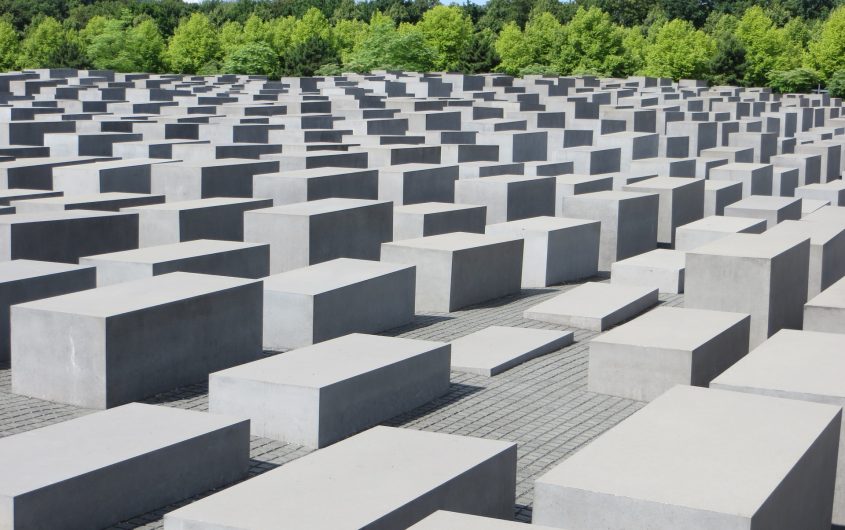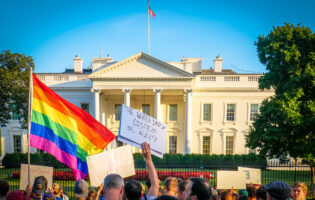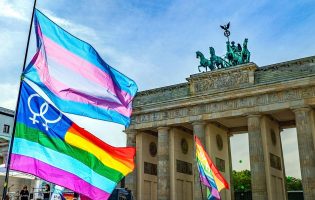
Dealing with the Past in Spaces, Places, Actions, and Institutions of Memory: Conference
The meeting, supported by the Stiftung Mercator and organized by the American-German Institute and Hafıza Merkezi, comprised three different, related elements: a traditional conference of presentations and discussion; a series of dinners with featured speakers; and site visits to places of memory in Berlin. Some thirty speakers from Germany, France, Poland, the Czech Republic, Turkey and the Balkans were involved, with an additional ten regional experts from Berlin as audience and participants in discussion. Speakers were mainly drawn from civil society organizations, but former government officials and parliamentarians, as well as scholars, were also represented. The goal of the conference was two-fold: mutual learning about the principle and practice of commemoration; and the development of an international network of individuals and organizations engaged in memory work. The event addressed general and specific issues related to commemoration.
Conference Presentations
French-German Reconciliation – Presentation from Corine Defrance
Memorialization, Remembrance, and Acts of Commemoration – Presentation from Hans-Christian Jasch
Four Faces of Omarska – Presentation from Mirjana Dragosavljevic
Memorialization, Remembrance, and Acts of Commemoration – Presentation from Jörg Lüer
European Solidarity Center – Presentation from Basil Kerski
A Look Inside the European Solidarity Center
Action Reconciliation Service for Peace – Presentation from Katharina von Münster
Institutional Expressions of Dealing with the Past – Presentation from Eckhardt Fuchs
Youth Initiative for Human Rights – Presentation from Mario Mazic
General Issues
Three topics stood out: the complexity of commemoration; the purpose of commemoration; and the utility of comparison across cases.
Complexity
Commemoration stands alone, but is also part of the two larger phenomena of facing the past and of reconciliation after conflict and major human rights violations and war crimes. Commemoration can express itself directly – for example, through memorials, museums, art installations – and indirectly, for example, through compensation, speech, trials and education. Commemorative acts can be internally directed or targeted externally toward former victim countries. Commemoration is rarely a linear process and is often contested.
In Germany, the external process was first, commencing already in 1945 in the Franco-German case and in 1951 in the German-Israeli example. Internal efforts followed in the late 1950s and 1960s concerning the Holocaust and reached a high point with President von Weizsäcker’s May 1985 speech and a subsequent wave of local initiatives. A new phase of memory work – this time related to the actions of the East German government – took place after 1989. Although the German process started early, in some areas initiatives have been quite new, for example the agreement to compensate slave and forced laborers (2000) and the opening of the Memorial to the Murdered Jews of Europe (2005). In Turkey, initiatives at internal commemoration – regarding the treatment of the Kurdish minority – and external commemoration – concerning the remembrance of the Armenian genocide – have been much more recent. The reality of the Balkans wars occurring only two decades ago render commemoration a very actual engagement in that region regarding both internal commemoration of civil and ethnic wars within countries and external commemoration of wars between post-Yugoslavia states.
While more straightforward than other country cases, Germany’s commemoration has revealed signs of contestation, the idea of “memory protest” (as opposed to “memory work”), for example debates over the continued presence of former Nazis in positions of authority, and the “68 generation” questioning of its parents and grandparents regarding World War II and the Holocaust. Starting in 2000, the notion of conflict over commemoration appeared again publicly in Germany with significant debates internally and with former victim countries over the issue of officially commemorating the experiences of German expellees. In former victim countries like the Czech Republic and Poland, in recent years there have been initiatives to commemorate the plight of German victims. In both the Balkans and Turkey, contestation seems to define commemoration processes, as does a “climate of impunity” more generally. In all three cases, there are examples of both direct and indirect commemoration.
Purpose
The main goal of commemoration is to honor the victims of atrocities by naming them and thereby reconstituting the identity of which they were robbed and, thereby, restituting their individuality and humanity. Commemoration institutionalizes a process of remembrance that can contribute to prevention and repetition of violence in the future and to the muting of revenge. Commemoration also entails naming the perpetrators, emphasizing that the goal of healing is two-sided. Commemoration can also drive systemic change and progress at both political and societal levels. Commemoration involves the search for truth and justice.
Comparison
The three cases explored by this project, Germany/Europe, Turkey and the Balkans, are quite different in terms of the stages of commemoration in which they find themselves – in Turkey and the Balkans, ”the past is hardly past” – and of the context of the histories and cultures in which they are situated. Even though transference is a tricky and sticky notion, comparison allows us to question our certitude about events, opens up ossified debates by injecting new ideas, and provides concrete examples of both opportunities and challenges. Even though Germany is a mature case of commemoration practices and, therefore, residing in a different stage from Turkey and the Balkans, understanding the origins and outcomes of the German process can be instructive if we bear in mind contextual, historical and cultural differences. After all, there are no other cases of systematic and sustained confrontation with the past from which we might draw lessons.
Specific Topics
Over the course of the three-day meeting, three major topics and questions emerged:
• The multiple instruments of commemoration: how do people commemorate the past?
• The varied actors of commemoration: who commemorates?
• The power relationship between civil society and governments: who sets the agenda of commemoration?
The following summary addresses these three areas in each geographical case.
Germany
Instruments
Germany stands out for the range of instruments it has utilized (each with variants) to confront history and commemorate the past and its victims: formal acknowledgement of crimes, including apologies and statements of regret; museums; memorial sites (the creation of and official visits to) both large (concentration camps) and small (stumble stones); truth and fact-finding commissions; textbook commissions; education; research entities; trials; material compensation; days of remembrance; youth exchange. Germany’s processes of commemoration have been marked by a high degree of institutionalization, by a sustained regularity, and by a non-linear development. The narratives about history at the heart of commemoration are diverse, with examples of “consensual narrative,” “dual narratives,” and “multi-perspectival narratives.”
Actors
A key player in German commemorative undertakings has been civil society organizations, often preceding the formal activities of government. Religious entities such as Action Reconciliation Service for Peace and organized religions such as the Catholic and Protestant churches were at the forefront of German reconciliation initiatives. Friendship societies and town twinnings have also been important for commemoration, as have scholars and veterans’ organizations and the German War Graves Commission. German governments of various political stripes have been committed to policies of commemoration.
In the German case, whether involving official or non-governmental activities, there has been a dual focus on both victims and perpetrators, with both categories leading to hierarchies of victimhood and perpetrator identities.
Germany’s commemoration of the past has been aided by two other sets of actors: third parties, principally the United States, and individual political and societal leaders who demonstrated courage when commemorative acts were unpopular.
Power Relationships
By acting as catalysts, non-governmental actors have been agenda-setters, influenced governments and charted an independent path. However, they also have relied on governments for some degree of funding. In addition to its own trajectory of commemoration, the German government has frequently codified the work of civil society in formal agreements. The German parliament as a collective body and German politicians as individuals have frequently played a special role in working with governments and civil society to initiate and sustain commemoration.
The Balkans
Instruments
In the Balkans, commemoration activities have focused on the need for restorative approaches to truth and justice and democratization, and at the same time on the ongoing requirement of war crimes monitoring, fact-finding mechanisms, detecting the missing and support for the domestic judiciary in order to end impunity. Twenty years after Dayton there are some (although contested) achievements in these areas, but a lot remains to be done. There is a clear necessity to shift transitional justice strategies from retributive to restorative approaches that are more oriented towards the victims: acknowledgement (“naming the victims”); providing material and symbolic reparations; healing, trust-building and relationship building.
The need for spaces where alternative narratives of history can be shared was highlighted, even if not much hope was expressed that alternative textbooks will be implemented in the formal educational system (i.e. curricula of schools and universities) in the short run. Youth exchange, as with textbooks borrowing from the Franco-German and German-Polish examples, is seen as a productive route, especially now that there is agreement in the region for a Western Balkans Youth Office. Initiatives concerning youth in general are viewed as salutary for changing ingrained perspectives about the past.
Concrete memorials such as the art project to remember and validate the victims of war crimes in the camp located at the Omarska mine in northern Bosnia Herzegovina help fill a blank space of public “oblivion” and forgetting.
The August 2015 visit of the Prime Minister of Serbia to Srebrenica for the twentieth anniversary of the massacre has not been accepted as a gesture for reconciliation but as an act of provocation by many Bosniaks who lost their relatives in Srebrenica in 1995. Prime Minister Vucic continues to avoid the term “genocide” and is still hesitant to clearly name the involvement and responsibility of Serbian politics in these events. In this context, it was noted that political gestures and official apologies are sometimes much more directed toward the international community (the EU, in this case) and cannot count on reciprocity if the message is ambivalent and if the integrity and legitimacy of the respective political leaders remain contested.
Actors
Civil society actors, including peace and human rights activists, have been central in Balkans commemoration efforts. Women’s organizations have also been active, responding to the stark reality of rape as a tool of war in the Balkans of the 1990s. Governments have been less engaged in commemorative work aimed at reconciliation.
Various forms of collective victimhood exist and persist in the region of the former Yugoslavia and form obstacles to reconciliation between and within these societies. Another problem is the fact of different hierarchies of victims: as the victims of one’s own side are considered more important than the victims of the other side, and societies continue to nurture selective forms of remembrance and acknowledgement, commemoration work can be easily manipulated or abused for political purposes.
As to external actors, the EU has been engaged to some extent in trying to facilitate commemoration and reconciliation, but its efforts suffer from a lack of coordination and the absence of an overall transitional justice strategy.
Rather than being positive forces for commemoration of the “other” and reconciliation initiatives, individual political leaders are seen as an obstacle to healing.
Power Relationships
Some observers feel that civil society organizations at the grass roots level are driving commemoration and “do not need politicians for this [work].” Other human rights activists insisted that in order to establish constructive processes of dealing with the past and inclusive cultures of memory, initiatives both from civil society and the political level (governments, state institutions, parliaments and local authorities) are needed, and that the alternative is not “either” “or.” This can lead to active cooperation with political authorities, or to independently monitoring the behavior of state institutions. Interaction between civil society and state institutions is seen as crucial for institutional and legal change, sometimes leading to the government acting as the agenda-setter.
Turkey
Instruments
Commemoration activity in Turkey has underscored the pursuit of truth and justice in the context of democratization. Hafıza Merkezi, an independent human rights organization, is emblematic of this search by aiming to uncover the truth concerning past violations of human rights, strengthen the collective memory about those violations, and support survivors in their pursuit of justice. It was established in November 2011 by a group of human rights activists, journalists and lawyers to advocate for an adequate institutional and societal response to past grave violations of human rights. Its assembling of memorial projects referencing the last one hundred years in Turkey speaks to the range of possible public commemorative activity: “statues, parks, or museums, or less permanent commemorations such as demonstrations, theatrical productions, and traveling exhibitions.” The naming of both victims and perpetrators is central to this work.
The organization has emphasized the plight of Kurdish victims of state behavior, a focus also featured in the work of the Diyabakir Prison Initiative to remember individual and collective suffering of Kurds in that location. The ongoing conflict between state authorities and Kurdish groups makes it difficult to identify the parameters of memorialization at the same time that the commemoration imperative becomes even more urgent. New layers of history atop old strata of the past complicate contemporary memory work.
A second dimension of Turkish memorialization relates to the Armenian genocide. Here discussion, debate and contestation among politicians, activists and academics have revolved around three aspects: the language used to describe the events of mass slaughter in April 1915; the identification and disaggregation of the perpetrators; the possibility of contemporary relations between Turkey and Armenia.
At the local level, projects like the Habap Fountains Initiative aim to restore both physical spaces and the identity of the people who formerly lived there. The restoration of the fountains in eastern Anatolia, built by Armenians and destroyed by new residents after Armenians were forced to leave, has brought together Armenian, Kurdish and Turkish groups in an effort at reconciliation.
Actors
As in the German and Balkans cases, civil society actors – whether human rights and peace activists, scholars, or journalists – have been crucial initiators of efforts to remember the past and to commemorate. The government has been a more hesitant, sporadic player, falling short of victims’ expectations. There is virtually no agreement about who is a victim and who is a perpetrator. Narratives about the past are highly conflictual. As in the Balkans, Turkish practitioners underscored the need for a “gender-sensitive approach to peace and reconciliation.”
Power Relationships
Some small incidents of government-civil society cooperation on commemoration were mentioned, but to a large extent the relationship between non-governmental organizations committed to commemoration and the government is adversarial and the ability of civil society to set the memorialization agenda is very limited.







